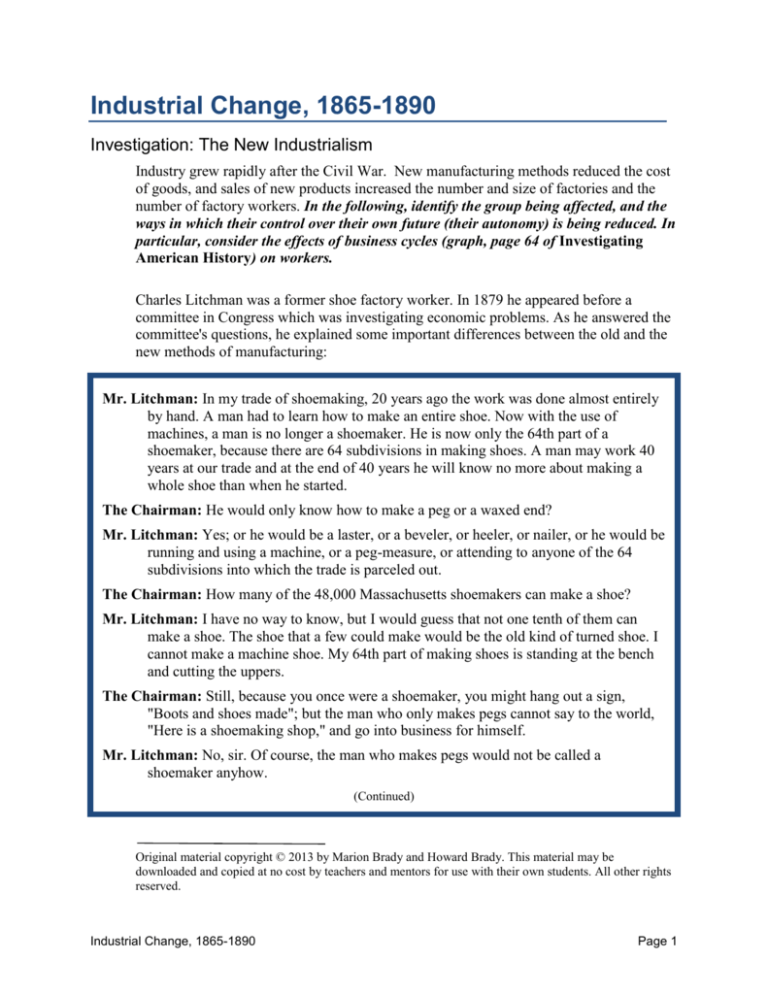
Industrial Change, 1865-1890
Investigation: The New Industrialism
Industry grew rapidly after the Civil War. New manufacturing methods reduced the cost
of goods, and sales of new products increased the number and size of factories and the
number of factory workers. In the following, identify the group being affected, and the
ways in which their control over their own future (their autonomy) is being reduced. In
particular, consider the effects of business cycles (graph, page 64 of Investigating
American History) on workers.
Charles Litchman was a former shoe factory worker. In 1879 he appeared before a
committee in Congress which was investigating economic problems. As he answered the
committee's questions, he explained some important differences between the old and the
new methods of manufacturing:
Mr. Litchman: In my trade of shoemaking, 20 years ago the work was done almost entirely
by hand. A man had to learn how to make an entire shoe. Now with the use of
machines, a man is no longer a shoemaker. He is now only the 64th part of a
shoemaker, because there are 64 subdivisions in making shoes. A man may work 40
years at our trade and at the end of 40 years he will know no more about making a
whole shoe than when he started.
The Chairman: He would only know how to make a peg or a waxed end?
Mr. Litchman: Yes; or he would be a laster, or a beveler, or heeler, or nailer, or he would be
running and using a machine, or a peg-measure, or attending to anyone of the 64
subdivisions into which the trade is parceled out.
The Chairman: How many of the 48,000 Massachusetts shoemakers can make a shoe?
Mr. Litchman: I have no way to know, but I would guess that not one tenth of them can
make a shoe. The shoe that a few could make would be the old kind of turned shoe. I
cannot make a machine shoe. My 64th part of making shoes is standing at the bench
and cutting the uppers.
The Chairman: Still, because you once were a shoemaker, you might hang out a sign,
"Boots and shoes made"; but the man who only makes pegs cannot say to the world,
"Here is a shoemaking shop," and go into business for himself.
Mr. Litchman: No, sir. Of course, the man who makes pegs would not be called a
shoemaker anyhow.
(Continued)
Original material copyright © 2013 by Marion Brady and Howard Brady. This material may be
downloaded and copied at no cost by teachers and mentors for use with their own students. All other rights
reserved.
Industrial Change, 1865-1890
Page 1
The Chairman: Does this rule which you have applied to the manufacturing of shoes apply
to all other branches of manufacturing industry?
Mr. Litchman: For the most part, yes. I have no hesitation in saying that. It applies to every
trade, even stonecutting.
In 1883, machinist John Morrison gave this testimony before a Senate committee:
Morrison: The different branches of the trade are divided and sub-divided so that one man
may make just a particular part of a machine and may not know anything whatever
about another part of the same machine. In that way machinery is produced a great
deal cheaper than it used to be formerly. By the use of machinery and the subdivision
of the trade they so simplify the work that it is made a great deal easier and put
together a great deal faster. There is no system of apprenticeship, I may say, in the
business. You simply go in and learn whatever branch you are put at, and you stay at
that unless you are changed to another.
Interviewer: Does a man learn his branch very rapidly?
Morrison: Yes, sir; he can learn his portion of the business very rapidly. Of course he
becomes very expert at it, doing that all the time and nothing else, and therefore he is
able to do a great deal more work in that particular branch than if he were a general
hand and expected to do everything.
Following is a description of work in a steel mill about 1900:
The nature of the work, with the heat and its dangers, makes much of it exhausting.
Yet these men for the most part keep it up 12 hours a day. It is uneconomical to have the
plant shut down. In order that the mills may run practically all the time, the 24 hours is
divided between two shifts. Most of the men employed in making steel (as distinct from the
clerical staff) work half of the time at night. The usual arrangement is for a man to work one
week on the day shift and the next week on the night shift. At the request of the men, the
night turn is made longer, so that they can have the full evening to themselves the other
week. Their hours on the day turn, therefore, are from 7:00 A.M. to 5:30 P.M. This leaves
thirteen and one half hours for the night shift.
Page 2
Industrial Change, 1865-1890
Rules adopted by the Cambria Iron Works on April 6, 1874:
Any person known to belong to any secret organization whose aim is to control wages or
stop the works, shall be promptly and finally discharged. Persons not satisfied with their
work or their wages can leave honorably by giving the required notice.
Any person going to work intoxicated, or absenting himself from work, without having
previously given notice and obtained leave, will be discharged or fined, at the option of
the company. Any person failing to do his work in a proper manner, or failing to do a
satisfactory amount, may expect to be dismissed whenever it may suit the convenience of
the company.
Quarreling or rioting on the company's premises, shall be punished by a fine of not less
than 5 dollars nor more than 10 dollars, or the discharge of the offender, who may also be
prosecuted for violation of the law.
All money collected as fines and penalties will be set apart and reserved for those
workers injured by accident.
Persons found stealing coal will be charged the price of a load of coal for every lump
stolen. For a repetition of the offense they will be discharged.
Persons living in the company's houses will be charged for all damages done to the
houses beyond the ordinary wear and tear. They will be forced to leave at once upon
ceasing to be employed by the company. In renting the houses, preference will always be
given to those whose business requires them to live near the works.
A contract offered in 1880 to employees of a tobacco manufacturer. In its factory in
Jersey City, New Jersey, the company employed about 4,000 men, women, and children.
I, the undersigned, in consideration of employment being offered to me and wages
agreed to be paid me, by the firm of ****** do hereby agree to allow the said firm to search
and examine my person, clothing, or other personal effects and property at any and all times
while I am upon the premises of said firm, or while leaving the said premises.
I will also allow the said firm to enter and search my house to determine whether I
have taken any of its property.
I do further agree that all injury to life, limb, body, or health, by reason of my
employment by said firm shall be at my own risk. I will not prosecute said firm because of
any injury that may occur to me, in or upon the premises of the said firm or when about the
business of the said firm.
I hereby agree to faithfully observe and keep the rules of said firm, and will promptly
obey the orders of my foreman and other superiors. Witness my hand this ____ day of
________ 18___.
Industrial Change, 1865-1890
Page 3
The following information is from an 1884 investigation conducted by the state of
Massachusetts into the living and working conditions of the working girls of Boston.
In the manufacture of Buttons, the girls say the work is rather dangerous, as they are
liable to get their fingers jammed, or caught in the die when it comes down to press the parts
of the button together. A man (although not a surgeon) is provided to dress wounds three
times for each individual without charge. Afterwards, the person injured must pay all
expenses. There are 35 machines in use, and accidents occur often.
In making Paper boxes, the girls must stand, a practice they think is very harmful.
The coloring matter in materials used in the construction and covering of boxes is considered
dangerous to health by some, one girl being at home sick three months from blood poisoning
caused by work.
In the Clothing business, the general testimony is that the work is very hard, and is
the cause of much sickness among the working girls. The tax on the strength is great, and it
would seem that unless a girl is strong and robust, the work soon proves too hard for her, and
if followed thereafter results disastrously.
Children working in a textile
factory, 1880s:
In 1880 there were 1,118,000
children under sixteen (one out
of six) at work in the United
States.
Page 4
Industrial Change, 1865-1890
The table below suggests something about the autonomy of many Americans in 1884.
The statistics are for Illinois, but are fairly typical of the rest of the United States at that
time.
WORKER WAGES 1884
Average annual wages for day laborers
$344.59
Average annual wages for carpenters
$552.44
Average annual wages for locomotive engineers
$1,076.00
Average number of days worked each week
6
Average number of hours worked each day
10
No vacation or sick pay.
Workers were laid off an average of 8 weeks each year without pay.
Compute how much a worker in one of the categories shown in the table made per
hour in 1884.
Prices in Illinois:
COST OF GROCERY ITEMS, 1884
Item
Price (cents)
Bread, white, per loaf ............................ 6
Crackers, per pound .............................. 9
Milk, per quart....................................... 6
Coffee, roasted, per pound .................. 21
Tea, common, per pound..................... 52
Sugar, brown, per pound ....................... 9
Eggs, per dozen ................................... 17
Butter, per pound................................. 26
Cheese, per pound ............................... 17
Molasses, per gallon ............................ 62
Soap, per pound..................................... 6
Baking powder, per pound .................. 39
Bacon, per pound ................................ 14
Beef, corned, per pound ...................... 10
Beef or pork, roast, per pound............. 12
Poultry, per pound ............................... 13
Hams, smoked, per pound ................... 15
Fresh fish per pound ............................ 10
Beans, per quart................................... 10
Canned fruit, per can ........................... 18
Raisins, per pound ............................... 13
Vinegar, per gallon .............................. 26
Industrial Change, 1865-1890
Make a shopping list of five items from the
list, and find the total cost. How long would a
worker in the category you chose above have
to work to buy these items?
Check the prices of the same five items in
your local supermarket, then determine the
hourly wage of a similar worker today. How
is the buying power of the worker today
different from that of the worker in 1884?
How does buying power affect a person's
autonomy?
.
Page 5
Investigation: Ideas of Industrial Leaders
In the early days of the United States, a few individuals had great influence on the
country—leaders such as George Washington, John Adams, Thomas Jefferson,
Alexander Hamilton, and James Madison. These men had political power, and they used
it to create a government based on their ideas and values.
A hundred years later, power was again in the hands of a few people, but they were
industrial rather than political leaders—men like John D. Rockefeller, Cornelius
Vanderbilt, his son William Henry Vanderbilt, Andrew Carnegie, and J. P. Morgan. They
controlled banks, factories, railroads, refineries, mines and mills. Like the founders of our
country, they used their power to bring about changes based on ideas and values
important to them.
The materials which follow are from speeches, articles, and interviews of several of the
powerful industrial leaders of America in the late 1800s. This information mainly
describes their attitudes toward the working class. Identify relationships between these
attitudes and autonomy, or lack of it, of workers and their families.
Industrial leaders had strong ideas about success and failure. The English writer Herbert
Spencer put the reasons for those ideas into words. His opinions were popular with many
the wealthy, and he became a close friend to several of them. A passage from his book,
Social Statics, published in 1850:
Nature operates according to a law that may seem cruel but is really very kind. It is
this: When an animal gets old and feeble and can no longer enjoy life, it is killed by another
animal. The same thing happens to those animals that are sick, deformed, or slow.
This is a good thing, because it gets rid of the inferior animals before they have a
chance to bear young ones like themselves. Only those that are well-suited to their
environment survive.
This same law of nature applies to human beings too. When those who don't know
how to do anything are poor, when those who aren't wise have problems, when those who
aren't working starve, and when the strong shove everyone else out of the way, this is for the
best.
It may seem sad that an unskillful or sick worker goes hungry; it may seem sad that
widows and orphans are left on their own to live or die, but in the long run this is best. It
works for the good of humanity, just as an epidemic does when it kills off those who have
the least resistance. Unfortunately, there are a lot of soft-hearted people who don't like this
law, and are constantly interfering with it. They feel sorry for the poor, weak, and helpless,
and do things to help them out. This is the exact opposite of what they ought to do. These
well-meaning but blind people can't see that because they are fighting nature's way of getting
rid of the unhealthy, stupid, and slow, they are increasing the number who will eventually
have to be helped.
Page 6
Industrial Change, 1865-1890
Andrew Carnegie began his career as a laborer, but went from “rags to riches” rapidly.
Ability, hard work, and luck helped him make several hundred million dollars in the steel
industry. Here are excerpts from a magazine article Carnegie wrote in 1889.
In the last few hundred years, there has been a revolution. There used to be very little
difference between the way of life of a community's leaders and the ordinary people. Now
however, there is a tremendous difference between the palace of the millionaire and the
cottage of the laborer.
But this change is really a very good thing. In fact, it's absolutely necessary for the
progress of humanity, because it is the rich who preserve the best literature and art and the
other refinements of civilization.
Here's how to solve the problem of poverty: Don't pass any laws controlling either
how businessmen make money or what they do with it. Most of the community's money will
then end up in the hands of a few men, but this is all right if these men consider themselves
not as owners of the money but merely as temporary keepers of it. Because these men are
wise (or they wouldn't be rich) they will be able to make good decisions about how to spend
the money to help the community. In fact, their decisions will be better than those of the
people of the community themselves.
An interview with William H. Vanderbilt, president of the New York Central Railroad:
Vanderbilt: The railroads are not run for the benefit of the "dear public"—that cry is all
nonsense—they are built by men who invest their money and expect to get a fair
percentage on the same.
Interviewer: Does your Limited Express [railroad] pay?
Vanderbilt: No, not a bit of it. We only run it because we are forced to do so by the action
of the Pennsylvania road. It doesn't pay expenses. We would abandon it, if it was not
for our competitor keeping its train on.
Interviewer: But don't you run it for the public benefit?
Vanderbilt: The public be d-----d. What does the public care for the railroads except to get
as much out of them for as small a consideration as possible? I don't take any stock in
this silly nonsense about working for anybody's good but our own.
Interviewer: Referring to wages paid your employees, do you consider that they are
generally what they should be?
Vanderbilt: Yes, I do. There are always a lot of shiftless fellows who spend their money in
drink and riotous living, who are ready to complain of anything.
Key words for Internet or library search: “Gilded Age,” “Robber Barons,” “Standard Oil
Company history.”
Industrial Change, 1865-1890
Page 7
The attitudes you've been exploring affected more than poor workers and their families.
In 1889 George Rice, owner of an oil company, testified before the United States
Industrial Commission:
My refinery was forced out of business three years ago by the Standard Oil Trust.
They did it partly by using their power to force the railroads to give them lower freight rates
than I was able to get.
That was only part of the problem. I could sell my oil at two to three cents a gallon
cheaper than Standard Oil and still make a nice profit. But because they were so big, they
could afford to go to my customers and offer them oil even below the cost of producing it. Of
course, after I was driven out of business, my old customers had to pay whatever Standard
Oil demanded.
These kinds of savage attacks clearly show both their power to do evil and the
uselessness of trying to fight them.
In 1903, John D. Rockefeller Jr., son of the founder of Standard Oil, said:
The growth of a large business is merely a survival of the fittest. The American
Beauty rose can be produced in the splendor and fragrance which brings cheer to its beholder
only by sacrificing the early buds which grow up around it. This is not an evil tendency in
business. It is merely the working-out of a law of nature and a law of God.
A visitor to a Massachusetts factory describes the attitude of its manager:
I inquired of the manager of a major factory whether it was the custom of the
manufacturers to do anything for the physical, intellectual, and moral welfare of their
workpeople. “We never do,” he said. “As for myself, I regard my workpeople just as I regard
my machinery. So long as they can do my work for what I choose to pay them, I keep them,
getting out of them all I can. What they do or how they fare outside my walls I don't know,
nor do I consider it my business to know. They must look out for themselves as I do for
myself. When my machines get old and useless, I reject them and get new, and these people
are part of my machinery.”
Herbert Spencer and the industrial leaders make some assumptions about the cause of
poverty. What are these assumptions? Are they valid and true? How could you find
out?
What is your own opinion about these ideas? Write a description of your own ideas and
feelings about rich and poor, and about the proper treatment of poor people.
Page 8
Industrial Change, 1865-1890
Acknowledgements/Sources:
Page 1: "Testimony of Charles H. Litchman,” Causes of the General Depression in Labor and Business,
Investigation by a Select Committee of the House of Representatives, 46th Congress, 2nd session, Misc.
House Doc. No.5, 1879. 2t: Testimony of John Morrison before Senate Committee on Labor and Capital,
Report of, vol. 1. 2b: William H. Ghent, Our Benevolent Feudalism, 1903. 3t: "Rules Adopted by the
Cambria Iron Works," April 6, 1874. 3b: Fall River Labor Standard, June 5, 1880. 4: The Working Girls of
Boston, from the 15th Annual Report of the Massachusetts Bureau of Statistics of Labor, 1884. 5: Chart
from Third Annual Report, 1884, Illinois Bureau of Labor Statistics. 6: Herbert Spencer Social Statics,
1850. 7t: Andrew Carnegie, "Wealth," North American Review, CXLVIII, 1889 7b: Chicago Daily News,
Oct. 9, 1882. 8t: U.S. Industrial Commission Report, I, House Document #476, 56th Congress, 1st session,
1899. 8c: Byington, Homestead. 8b: Massachusetts Senate Document no. 21, 1868
Notes for Teachers and Mentors:
This unit is an extension of Part 10 of Investigating American History. The focus is on
autonomy—control over one’s own fate—and the several reactions to stress that occur
when autonomy is threatened or thwarted. The spectrum of reactions is large (see list in
student materials in “Investigation: Problems in Late 19th Century America”). When
significant groups or classes feel the stress of lowered autonomy, the result is often
material for news—and for history books.
In the period after the Civil War in the United States, the growth of industry and the
resulting increase in urban population made many Americans vulnerable to exploitation
on the job, and to unemployment during manufacturing downturns. Even farmers
suffered when railroads—often the only way of transporting crops to market—drained
away their profits with excessive rates. As a result, every one of the nine possible
reactions to social stress occurred during the historical period covered here.
On an individual level, levels of worker autonomy and job satisfaction are closely linked.
Autonomy is also an important but unappreciated factor in education. According to the
Coleman Report on education (1966):
“…a pupil attitude factor, which appears to have a stronger relationship to
achievement than do all the “school” factors together, is the extent to which an
individual feels that he has some control over his own destiny…”(p. 23)
Industrial Change, 1865-1890
Page 9









